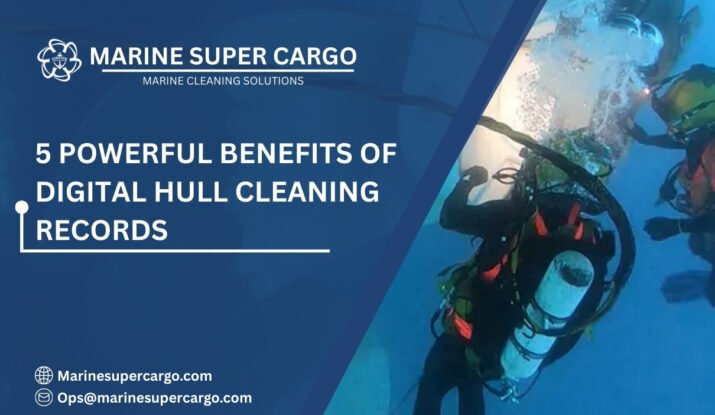Picture this: You’re docked at a busy international port, and an inspector asks for proof of your last hull cleaning. In the old days, you’d shuffle through logbooks, paper certificates, and maybe even faded Excel sheets, hoping the dates lined up. Today, there’s a smarter way—Digital Hull Cleaning Records, backed by blockchain technology.
These aren’t just files on a server; they’re tamper-proof, transparent, and future-ready. Think of them as a digital passport for your ship’s hull—recognized across ports, trusted by regulators, and invaluable for your fleet’s reputation.
In this article, we’ll explore how blockchain and digital reporting are reshaping record-keeping, why it matters for compliance and cost, and how ship owners, operators, and managers can embrace this change.
Why Hull Cleaning Records Matter
Hull cleaning is not a minor housekeeping task—it’s a regulatory, environmental, and financial concern. Proper records serve three essential functions:
- Compliance assurance: Proves your vessel follows IMO biofouling and MARPOL Annex V rules.
- Efficiency tracking: Links cleaning schedules with fuel consumption patterns.
- Risk management: Reduces delays or penalties during port state inspections.
Without accurate tracking, you’re exposed to fines, reputational risk, and even detention.
The Problem with Traditional Record-Keeping
Paper records and spreadsheets have long been used for hull cleaning documentation, but they’re riddled with issues:
- Inconsistency: Different cleaning vendors and crews maintain different logs.
- Prone to error: Manual entries can be incorrect or incomplete.
- Limited access: Records may be lost, misplaced, or unavailable when inspectors request them.
- Vulnerable to fraud: Paper signatures are far easier to forge than digital confirmations.
In a world where regulators demand transparency, this approach leaves operators exposed.

The Rise of Digital Hull Cleaning Records
Enter Digital Hull Cleaning Records. Imagine replacing messy records with a single, digital log updated in real time. These records:
- Log every cleaning operation with geotags, timestamps, and contractor IDs.
- Store performance data linked to hull monitoring systems.
- Provide instant visibility across fleets for owners and managers.
- Integrate with compliance reporting frameworks to satisfy regulators.
Instead of proving compliance reactively, you demonstrate it constantly. It’s like switching from paper tickets to e-boarding passes—efficient, trusted, and nearly impossible to fake.
Why Blockchain Elevates Digital Hull Cleaning Records
Blockchain acts like a digital notary. Each entry is recorded as an immutable “block” in a chain, time-stamped and validated across a distributed ledger.
Advantages include:
- Tamper-Proof: Once an entry is made, it cannot be altered retroactively.
- Transparency: Multiple authorized parties (owners, managers, regulators, ports) can view the same record.
- Verification: Cleaning vendor credentials, job details, and performance results are cryptographically verified.
- Audit Readiness: Automatic reports can be pulled during inspections.
Think of blockchain as the “black box” recorder for your hull—nothing gets lost, nothing gets faked.
How Digital Hull Cleaning Records Work
- Cleaning Event Logged: Diver, ROV, or robotic cleaning activity is recorded on-site.
- Data Entry: Operational details, waste disposal compliance, and hull inspection images are uploaded.
- Blockchain Validation: Entry is sealed and encrypted as a block.
- Fleet Access: Owners and managers view aggregated data on dashboards or mobile devices.
- Port Integration: Records are shared instantly with authorities through secure channels.
This process streamlines everything from operational planning to regulatory interactions.
The Compliance Dimension
Compliance is the main driver behind digital records. Key frameworks include:
- IMO Biofouling Management Guidelines (2011): Call for thorough documentation of hull cleaning events.
- MARPOL Annex V: Requires controlled discharge of cleaning waste—records prove compliance.
- IAPH Standards: Support port adoption of transparent, digital systems.
- IMCA Safety Guidance: Encourages digital alignment with diver and ROV cleaning practices.
Digital Hull Cleaning Records help vessels avoid non-compliance penalties while simplifying audits.
Benefits for Ship Owners and Operators
Integrating digital record systems creates tangible benefits:
- Reduced Downtime: Instant access to cleaning records speeds up inspections.
- Improved Efficiency: Links hull cleaning data with monitoring tools to optimize schedules.
- Port Trust: Demonstrates commitment to environmental standards.
- Long-Term Savings: Avoids fines, reduces fuel penalties, and strengthens operational reputation.
- Crew Relief: Eliminates paperwork, freeing time for real operational duties.
It’s more than convenience—it’s insurance against operational and financial risks.
Future Trends in Digital Hull Cleaning Records
The industry is rapidly evolving. Expect to see:
- Smart Contracts: Automated cleaning payments linked to completed record logs.
- Integration with AI: Predictive fouling models directly tied to digital records for proactive maintenance.
- IoT Connectivity: ROVs and robotic cleaners automatically upload verified records.
- Global Port Networks: Shared digital record platforms across major ports to standardize compliance.
- Environmental Analytics: Linking hull records with emissions data to drive decarbonization.
These moves transform records from static files into dynamic, fleet-wide performance assets.
⚓ Expert Underwater Hull Cleaning with Marine Super Cargo 🌊
— Marine Super Cargo (@Marinsupercargo) September 19, 2025
A clean hull means better performance, lower fuel use, and smoother voyages. Marine Super Cargo offers top Underwater Hull Cleaning to keep your vessel efficient, compliant, and ready for every operation. pic.twitter.com/sVKAUCytuS
Case Study: Container Operator Success
A container fleet operating Asia–Europe routes adopted blockchain-enabled Digital Hull Cleaning Records. Within a year:
- Port inspections took 30% less time.
- Compliance fines dropped to zero.
- Fuel efficiency improved by 8% as cleaning was better scheduled with monitoring data.
- Transparency boosted partnerships with eco-conscious clients.
This isn’t theory—it’s proof that digital systems deliver operational and financial payoffs.
Operational Best Practices
To maximize value from digital records:
- Standardize input formats across fleets for consistency.
- Train crew in digital tools to reduce manual errors.
- Integrate with performance monitoring software for measurable impact.
- Ensure secure data sharing with cleaning contractors and ports.
- Regularly back up blockchain nodes to avoid data accessibility gaps.
Done right, records will become not just proof but a strategic resource.

Cost vs. Benefit Perspective
Yes, implementation has upfront costs—blockchain platforms, integrations, crew training—but payback is rapid:
- Avoid penalties that can reach tens of thousands per inspection.
- Faster inspections reduce costly delays at busy hubs.
- Optimized cleaning translates into 5–10% fuel cost savings annually.
Digitalization isn’t an option anymore; it’s a competitive advantage.
Conclusion
Managing hull cleaning records with blockchain and digital systems is no longer futuristic—it’s today’s reality. Digital Hull Cleaning Records offer fleets tamper-proof compliance, improved efficiency, and stronger reputations.
Three key takeaways:
- Paper logs invite risks—digital records ensure integrity and compliance.
- Blockchain adds transparency, security, and audit readiness.
- Efficiency gains translate to real-time savings in fuel, downtime, and fines.
To future-proof your fleet, partner with experts like CleanShip.co who understand the power of digital hull compliance.
FAQs:
Q1. What makes digital hull cleaning records better than paper logs?
They eliminate errors, improve transparency, and are instantly accessible for audits, unlike paper logs that can be lost or forged.
Q2. How does blockchain ensure record integrity?
Every entry is timestamped, encrypted, and added to a distributed ledger, making it tamper-proof and verifiable.
Q3. Are digital hull cleaning records mandatory under IMO?
Not yet, but IMO encourages robust documentation, and many ports are moving toward accepting only digital submissions for faster compliance.
Q4. Do operators need technical training to use digital systems?
Minimal training is necessary. Most solutions are user-friendly and designed to integrate seamlessly with existing fleet management tools.
Q5. What’s the biggest future trend in this space?
Integration of records with AI predictive systems and port-based digital compliance networks for global standardization.


